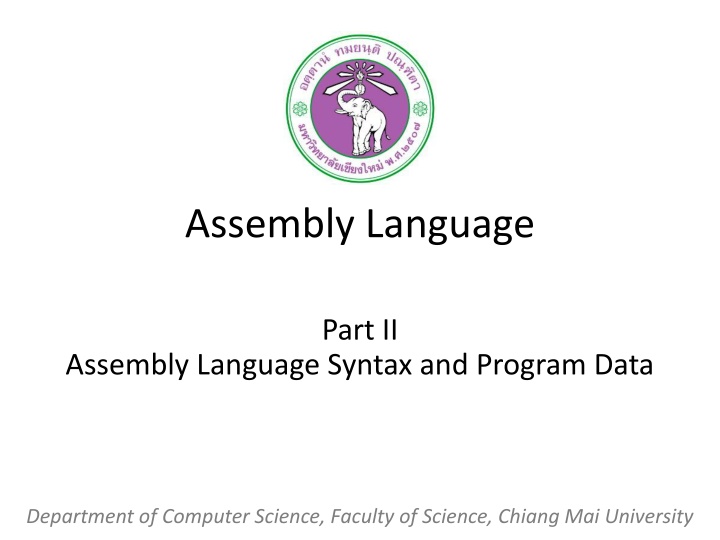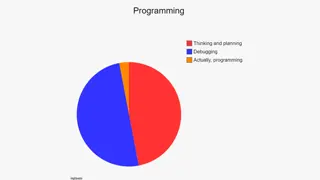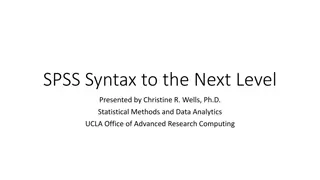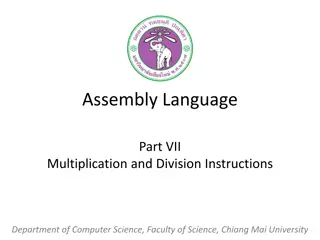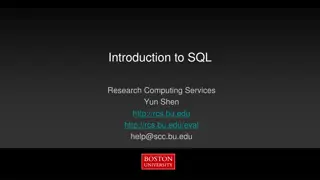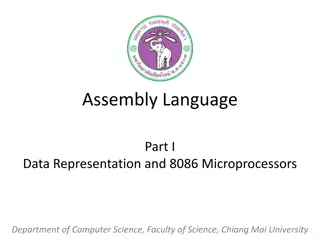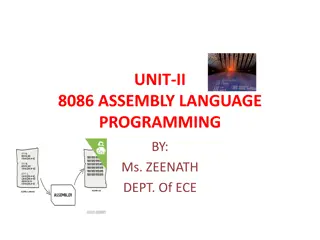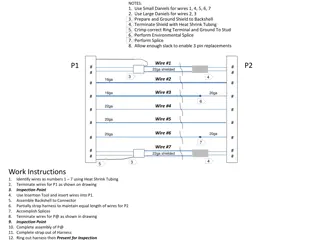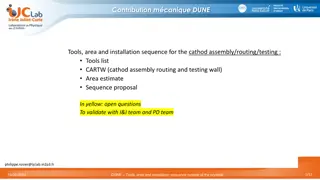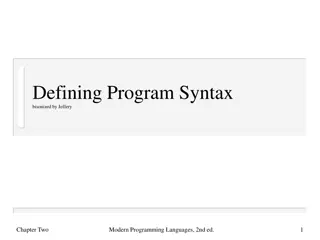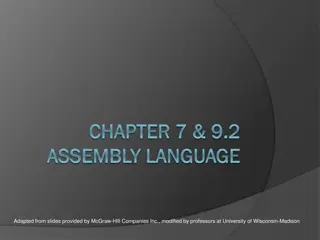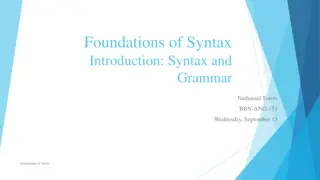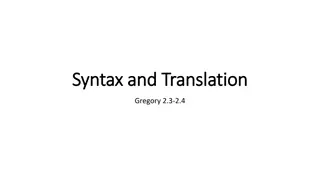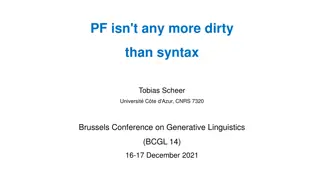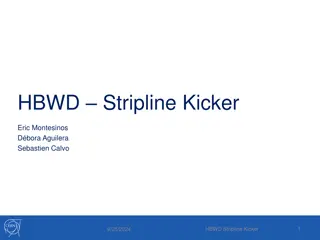Introduction to Assembly Language Syntax and Program Data
Learn about the syntax of assembly language and how data, variables, and constants are used in programming. Explore the basic instructions and the translation of high-level language into assembly language. Discover the role of an assembler in translating assembly language programs into machine language instructions, and understand the importance of instruction labels, procedure names, and variable names.
Download Presentation

Please find below an Image/Link to download the presentation.
The content on the website is provided AS IS for your information and personal use only. It may not be sold, licensed, or shared on other websites without obtaining consent from the author.If you encounter any issues during the download, it is possible that the publisher has removed the file from their server.
You are allowed to download the files provided on this website for personal or commercial use, subject to the condition that they are used lawfully. All files are the property of their respective owners.
The content on the website is provided AS IS for your information and personal use only. It may not be sold, licensed, or shared on other websites without obtaining consent from the author.
E N D
Presentation Transcript
Assembly Language Part II Assembly Language Syntax and Program Data Department of Computer Science, Faculty of Science, Chiang Mai University
Outline Statements Program Data Variables Named Constants Basic Instructions Translation of High-Level Language to Assembly Language 2 204231: Computer Organization and Architecture
Assembler Assembly language programs are translated into machine language instructions by an assembler, In an assembly language program we may express data as binary, decimal, or hex numbers, and even as characters. 3 204231: Computer Organization and Architecture
Instruction It is translated into machine code by the assembler. name operation operand(s) comment START: MOV CX, 5 ; initialize counter 4 204231: Computer Organization and Architecture
Assembler Directive It instructs the assembler to perform some specific tasks. such as allocating memory space for a variable or creating a procedure. MAIN PROC 5 204231: Computer Organization and Architecture
Name Field The name field is used for instruction labels, procedure names, and variable names. The assembler translates names into memory addresses. Names can be from 1 to 31 characters long. and may consist of letters, digits, and the special characters ? . @ _ $ %. 6 204231: Computer Organization and Architecture
Name Field Embedded blanks are not allowed. If a period is used, it must be the first character. Names may not begin with a digit. The assembler does not differentiate between upper and lower case in a name. 7 204231: Computer Organization and Architecture
Examples of Legal Names COUNTER1 @character SUM_OF_DIGITS $1000 DONE? .TEST 8 204231: Computer Organization and Architecture
Examples of Illegal Names TWO WORDS contains a blank 2abc A45.28 YOU&ME begins with a digit . not first character contains an illegal character 9 204231: Computer Organization and Architecture
Number Type 11011 11011B 64223 -21843D 1,234 1B4DH 1B4D FFFFH 0FFFFH Decimal Binary Decimal Decimal Illegal Hex Illegal Hex Number Illegal Hex Number Hex 10 204231: Computer Organization and Architecture
Characters Characters and strings must be enclosed in single or double quotes. "A" or 'hello' Characters are translated into their ASCII codes by the assembler, so there is no difference between using "A" and 41h in a program. "A" = 41h 11 204231: Computer Organization and Architecture
Data-defining Pseudo-op DB DW DD DQ DT Stands for Define Byte Define Word Define Doubleword Define Quadword Define Tenbytes 12 204231: Computer Organization and Architecture
Byte Variables name ALPHA BYT [-128, 127] for signed interpretation [0, 255] for unsigned interpretation DB DB DB initial_value 4 ? 13 204231: Computer Organization and Architecture
Word Variables name WRD [-32768, 32767] for signed interpretation [0, 65535] for unsigned interpretation DW DW initial_value -2 14 204231: Computer Organization and Architecture
Arrays B_ARRAY DB 10H, 20H, 30H Symbol B_ARRAY B_ARRAY+1 B_ARRAY+2 Address 0200h 0201h 0202h Contents 10h 20h 30h 15 204231: Computer Organization and Architecture
Arrays W_ARRAY DW 1000,40,29887,329 Symbol W_ARRAY W_ARRAY+2 0302h W_ARRAY+4 0304h W_ARRAY+6 0306h Address 0300h Contents 1000d 40d 29887d 329d 16 204231: Computer Organization and Architecture
High and Low Bytes of a Word WORD1 The low byte of WORD1 contains 34h, and the high byte contains 12h. The low byte has symbolic address WORD1, and the high byte has symbolic address WORD1+1. DW 1234H 17 204231: Computer Organization and Architecture
Character Strings LETTER DB LETTER DB MSG MSG ABC 41H, 42H, 43H HELLO , 0AH, 0DH, $ DB DB 48H, 45H, 4CH, 4CH, 4FH, 0AH, 0DH, 24H 18 204231: Computer Organization and Architecture
EQU The EQU (equates) pseudo-op is used to assign a name to a constant. name EQU LF EQU MOV DL, 0AH MOV DL, LF PROMPT EQU MSG DB MSG DB constant 0AH TYPE YOUR NAME TYPE YOUR NAME PROMPT 19 204231: Computer Organization and Architecture
MOV The MOV instruction is used to transfer data between registers, between a register and a memory location, or to move a number directly into a register or memory location. MOV destination, source MOV AX, WORD1 MOV AX, BX MOV AH, A 20 204231: Computer Organization and Architecture
XCHG The XCHG operation is used to exchange the contents of two registers, or a register, and a memory location. XCHG destination, source XCHG AH, BL XCHG AX, WORD1 21 204231: Computer Organization and Architecture
Legal Combinations of Operands for MOV Destination Operand Source Operand General Register Segment Register Memory Location Constant General Register Yes Yes Yes No Segment Register Yes Yes No No Memory Location Yes Yes No No Constant Yes Yes No No 22 204231: Computer Organization and Architecture
Legal Combinations of Operands for XCHG Destination Operand Source Operand General Register Memory Location General Register Yes Yes Memory Location Yes No 23 204231: Computer Organization and Architecture
Restrictions on MOV and XCHG ILLEGAL:MOVWORD1, WORD2 MOV AX, WORD2 MOV WORD1, AX 24 204231: Computer Organization and Architecture
ADD and SUB The ADD and SUB instructions are used to add or subtract the contents of two registers, a register and a memory location, or to add (subtract) a number to (from) a register or memory location. ADD destination, source SUB destination, source ADD WORD1, AX SUB AX, DX ADD BL, 5 25 204231: Computer Organization and Architecture
Legal Combinations of Operands for ADD and SUB Destination Operand Source Operand General Register Memory Location General Register Yes Yes Memory Location Yes No 26 204231: Computer Organization and Architecture
Restrictions on ADD and SUB ILLEGAL:ADD BYTE1, BYTE2 MOV AL, BYTE2 ADD BYTE1, AL ; AX gets BYTE2 ; add it to BYTE1 27 204231: Computer Organization and Architecture
INC INC (increment) is used to add 1 to the contents of a register or memory location. INC destination INC WORD1 28 204231: Computer Organization and Architecture
DEC DEC (decrement) subtracts 1 form a register or memory location. DEC destination DEC BYTE1 29 204231: Computer Organization and Architecture
NEG NEG is used to negate the contents of the destination. NEG does this by replacing the contents by its two s complement. NEG destination NEG BX 30 204231: Computer Organization and Architecture
Type Agreement of Operands MOV MOV MOV AX, BYTE1 AH, A AX, A ; illegal ; move 0041h into AX 31 204231: Computer Organization and Architecture
Translation of High-Level Language to Assembly Language Statement B = A Translation MOVAX, A; move A into AX MOVB, AX; and then into B 32 204231: Computer Organization and Architecture
Translation of High-Level Language to Assembly Language Statement A = 5 A Translation MOVAX, 5; put 5 in AX SUB AX, A; AX contains 5 A MOVA, AX; put it in A 33 204231: Computer Organization and Architecture
Translation of High-Level Language to Assembly Language Statement A = 5 A Translation NEG A ADD A, 5 ; A = 5 A ; A = A 34 204231: Computer Organization and Architecture
Translation of High-Level Language to Assembly Language Statement A = B 2 x A Translation MOVAX, B; AX has B SUB AX, A; AX has B A SUB AX, A; AX has B 2 x A MOVA, AX; move result to A 35 204231: Computer Organization and Architecture
Reference Ytha Yu and Charles Marut, Assembly Language Programming and Organization of the IBM PC. New York: McGraw-Hill, 1992. 36 204231: Computer Organization and Architecture
